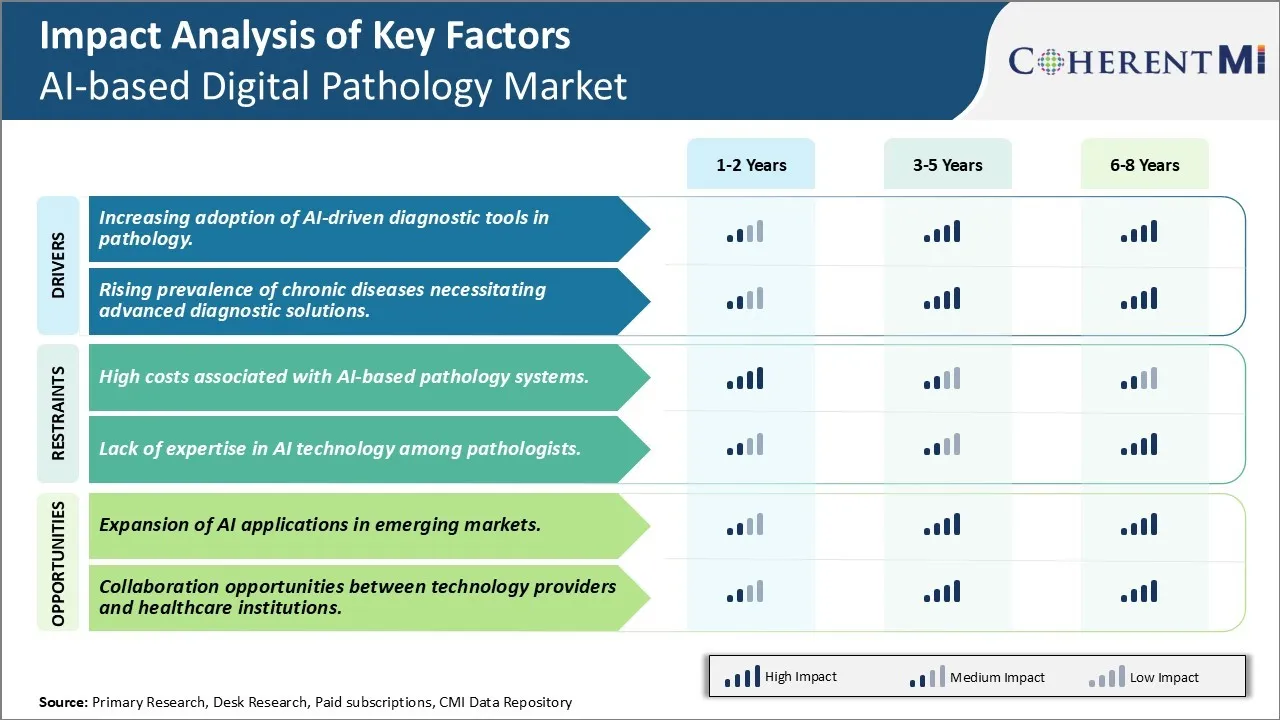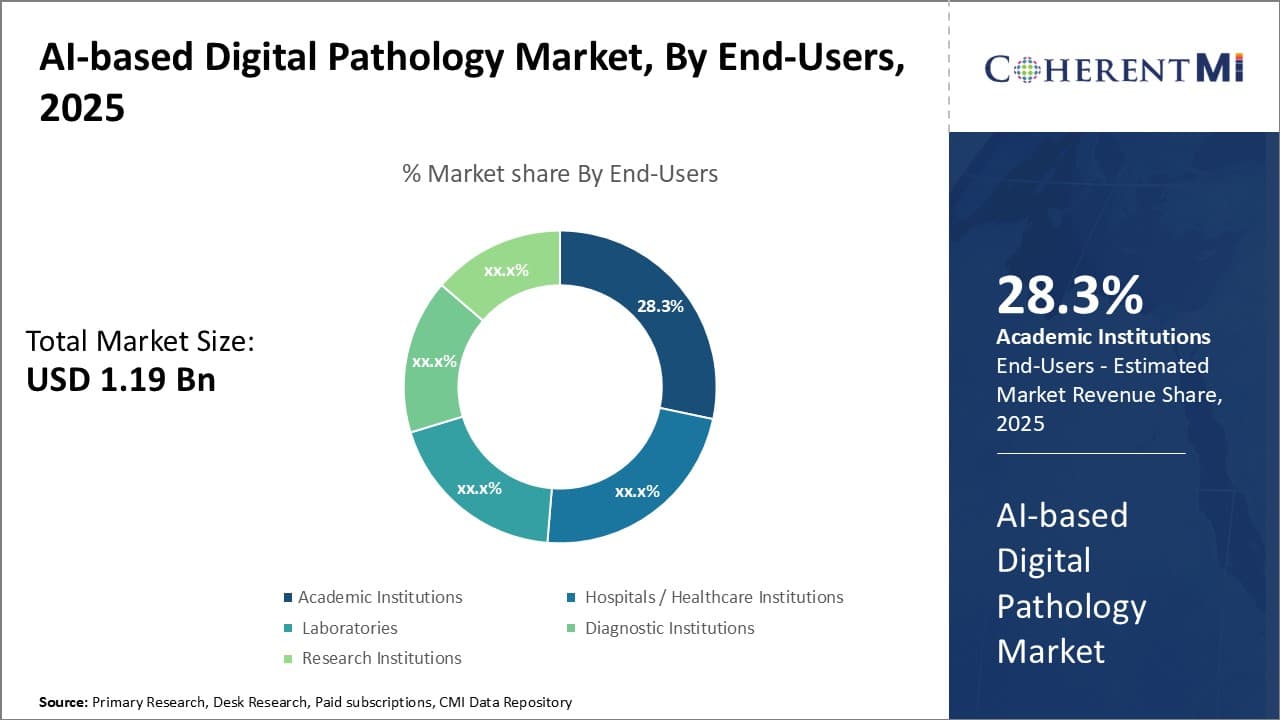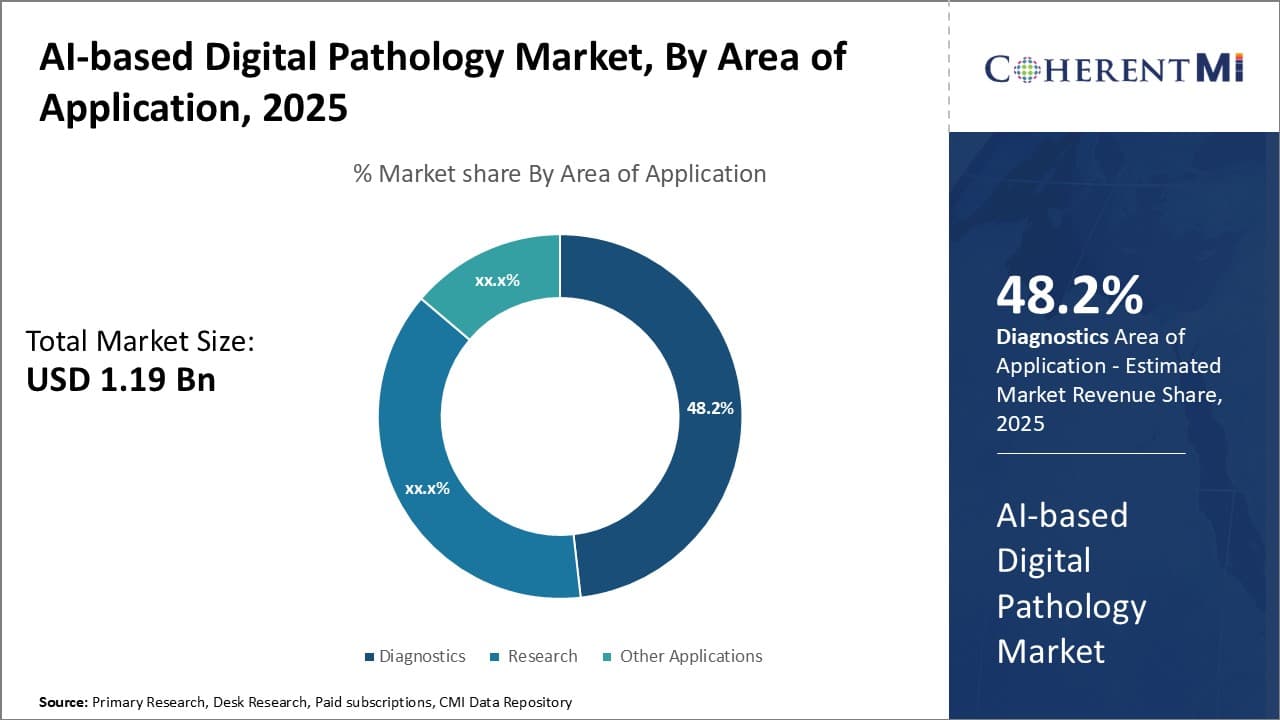

The AI-based digital pathology market is estimated to be valued at USD 1.19 Bn in 2025 and is expected to reach USD 2.11 Bn by 2032, growing at a compound annual growth rate (CAGR) of 8.5% from 2025 to 2032. The increasing incorporation of AI and digitization of pathology workflows along with the demand for more accurate and faster diagnosis is fueling the growth of this market.
The market is witnessing positive trends with the increasing adoption of digital pathology to enhance workflow efficiency in healthcare facilities. Key players are investing in development of more advanced AI and machine learning-based algorithms and systems to gain major share. Several hospitals and diagnostic centers are also replacing traditional microscopy with digital pathology to meet growing diagnosis needs.
Market Size in USD Bn
CAGR8.5%
| Study Period | 2025-2032 |
| Base Year of Estimation | 2024 |
| CAGR | 8.5% |
| Market Concentration | High |
| Major Players | Aiforia Technologies, Akoya Biosciences, Ibex Medical Analytics, Indica Labs, PathAI and Among Others |
Market Driver - Increasing adoption of AI-driven diagnostic tools in pathology
Pathologists are increasingly adopting AI-driven diagnostic tools to enhance their workflow and deliver more accurate diagnoses. Histopathological image analysis involves examining tissue slides under a microscope to detect diseases. However, manually analyzing hundreds of high-resolution images in a short period of time is a tedious and error-prone process. Moreover, the accuracy depends greatly on the pathologist's experience and fatigue levels. Artificial intelligence has demonstrated the ability to analyze digital pathology images much faster than humans and detect subtle visual patterns that may be missed by the naked eye. Several startups and large technology companies are now developing AI-based systems that can be trained on vast image datasets to recognize complex morphological features. Once validated in clinical settings, these tools are expected to significantly augment pathologists' diagnostic capabilities.
Many early adopters have reported reduction in diagnostic review time and improvement in consistency of reports through AI applications. For example, a pioneering study showed that an AI system could analyze whole slide images of biopsy samples and accurately detect breast cancer with a level of expertise comparable to experienced pathologists. This helped pathologists to prioritize difficult cases needing their urgent review. In another study, an AI-powered virtual microscope read prostate biopsies for Gleason grading of prostate cancer faster than pathologists usually do without compromising on accuracy. Such proven advantages are compelling hospitals and diagnostic laboratories to invest in digital pathology workflow along with AI-based algorithms. Vendors are also optimizing their platforms to seamlessly integrate with Laboratory Information Systems as well as Electronic Health Records for better clinical decision making.
Market Driver - Rising prevalence of chronic diseases necessitating advanced diagnostic solutions
Chronic diseases such as cancer, cardiovascular disease, and diabetes have been rising worldwide owing to aging populations and changing lifestyles. Cancer incidence alone is projected to continue increasing significantly in the coming decades. Treatment and management of chronic conditions puts a tremendous strain on healthcare systems both financially as well as in terms of workforce requirements. At the same time, early detection through accurate diagnostics can notably improve health outcomes in many chronic diseases. This necessitates pathology laboratories to examine an ever-growing number of samples routinely while maintaining highest standards of quality and turnaround time. AI applications are well-suited to help address these challenges by enhancing the efficiency and effectiveness of diagnostic workflows.
Advanced machine learning algorithms can extract insights from complex pathological images more objectively than humans to support early-stage cancer screening programs. Similarly, AI tools can help clinicians arrive at faster treatment decisions for heart disease patients through computational analysis of digitized cardiovascular tissue slides. Apart from aiding primary diagnosis, AI also enables computer-aided prognosis and monitoring of treatment responses in chronic conditions over time based on longitudinal health records. This presents opportunities for more personalized care approaches. Diagnostic labs, therefore, are proactively evaluating AI-powered digital solutions to scale their operations cost-effectively to cope with rising chronic disease case volumes while continuing to deliver expert levels of accuracy and reliability expected in healthcare.
 To learn more about this report, Download Free Sample Copy
To learn more about this report, Download Free Sample Copy
Market Challenge - High costs associated with AI-based pathology systems
One of the major challenges currently impacting the growth of the AI-based digital pathology market is the high costs associated with implementing such systems. Setting up whole slide imaging systems and the accompanying AI and computing infrastructure requires a significant capital expenditure that many hospitals and labs, especially those in smaller centers or developing countries, may not be able to afford currently. The need to digitize entire histopathology slide libraries retroactively also contributes to making these systems expensive to deploy initially. While the long term operational costs in terms of labor and consumables are reduced with digital pathology, persuading stakeholders to make such a large upfront investment continues to be challenging. The returns on such investments may also not be immediately clear. Affordability issues are thus a critical roadblock that needs to be addressed in order to allow broader adoption of this promising technology globally. Training pathologists and labs in handling and interpreting digital images also contributes to increased costs.
Market Opportunity - Expansion of AI applications in emerging markets
However, there also exists robust opportunities for the growth of AI-based digital pathology solutions. One such opportunity lies in the expansion of AI applications to emerging markets. While developed economies in the West have seen initial uptake of such technology, often spearheaded by major cancer centers and research hospitals, emerging markets remain relatively untapped. These regions are experiencing growing disease burdens such as cancer but face challenges such as shortage of pathologists and lack of resources.
AI and digital pathology offer the promise of improving efficiency, turnaround times, and accuracy of diagnosis. Vendors can focus on developing more affordable and customized solutions as well as translational research applicable to the public health needs and healthcare infrastructure in developing countries. This will allow the technology to reach regions with highest potential impact, driving volumes and revenues in the long run. Partnerships with local stakeholders will be important to facilitate customized adoption approaches. Emerging markets thus present a substantial opportunity area for continued growth of the digital pathology domain.
Players have focused on continuous innovation in their product offerings to provide improved diagnostics and analysis capabilities. For example, Philips introduced IntelliSite Pathology Solution in 2019, which uses AI and deep learning algorithms to analyze digital pathology images and extract quantitative data to assist pathologists. This solution analyzes whole slide images up to 50x faster than conventional methods.
Companies have partnered with pathology labs, hospitals and research institutions to advance the use of AI digital pathology and validate their solutions. For example, in 2020, Proscia partnered with The Johns Hopkins Hospital to deploy its AI image analysis platform, Cortex, across their pathology network. Such partnerships help accelerate clinical adoption and validation of AI solutions.
Leading players have acquired startups working on innovative AI and digital pathology solutions to enhance their product portfolios. For example, in 2019, Philips acquired IntelliSite to strengthen its position in precision diagnosis business using AI and machine learning. Similarly, Roche Diagnostics acquired Ventana Medical Systems in 2019, a leader in tissue-based cancer diagnosis, to integrate digital pathology and AI into their offerings.
Companies are focusing on expanding their geographical footprint, especially in high growth markets like Asia Pacific and Middle East, to capitalize on increasing demand. For instance, Nikon’s digital pathology business unit increased its international business by 25% in 2021 by expanding to countries like China, Brazil and India.
 To learn more about this report, Download Free Sample Copy
Insights, By End-Users: Increased focus on advanced medical education and research
To learn more about this report, Download Free Sample Copy
Insights, By End-Users: Increased focus on advanced medical education and research
In terms of end-users, academic institutions sub-segment contributes the highest share of 28.3% in the market owing to increased focus on advanced medical education and research. Integration of AI and advanced imaging techniques into curriculum and research projects has resulted in accelerated adoption of associated technologies.
A major factor propelling academic institutions segment is the need to impart hands-on experience and exposure to latest diagnostic practices to students. AI-based digital pathology solutions allow easy sharing of cases between faculty members and students which enhances learning outcomes. Adoption helps upgrade laboratory infrastructure as well as diagnostic capabilities of affiliated hospitals.
Growing public-private partnerships encourage academic centers to modernize facilities for collaborative research. AI algorithms developed using large datasets can be utilized to study disease mechanisms and boost efficacy of new drug development process. Research grants from government as well as private players promote equipping labs with cutting-edge tools. Integration of digital assets also aids publication of landmark studies.
Rising competitive pressure motivates institutions to focus on differentiating education programs. Advanced training in AI-powered analysis improves employability of graduates in rapidly evolving healthcare industry. Positive reputation boost associated with innovative research attracts talent as well as external funding. This establishes long term advantage over counterparts with conventional methodologies.
 To learn more about this report, Download Free Sample Copy
To learn more about this report, Download Free Sample Copy
Insights, By Area of Application: Benefits in workflow optimization and improved clinical decision making
In terms of area of application, diagnostics sub-segment contributes the highest share of 48.2% in the market owing to benefits in workflow optimization and improved clinical decision making. Diagnostics form the major application area for AI-based digital pathology owing to benefits in optimization of workflow as well as clinical decision-making process. Transition from conventional microscopic analysis to automated image scanning and interpretation improves efficiency multifold.
Pathologists are able to rapidly scan huge volume of slides and concentrate only on cases that warrant detailed evaluation. AI prioritizes urgent/suspicious cases to top of workflow. This ensures on-time reviews and reporting without compromising accuracy. Streamlined workflow allows optimal utilization of limited diagnostic resources.
Advanced AI algorithms match stained slide patterns to vast dataset of known disease characteristics with very high accuracy. Computer-assisted diagnosis augments diagnostic abilities of pathologists. Integration of patient history data further enhances clinical context. This fosters more consistent and objective diagnosis even for rare or complex cases.
AI solutions also enable quantitative analysis of biomarkers/indicators and generation of detailed reports. Standardization achieved through digitization and automation of quantitative methods aids multidisciplinary care decisions. Retrospective analysis of archival data or sequential samples is easy using AI-powered search tools.
In view of above advantages in turnaround time reduction, workload management, diagnostic consistency and treatment tracking - diagnostic application segment dominates AI-based digital pathology market currently and adoption is expected to accelerate further with improving accuracy and capabilities of deep learning models.
The major players operating in the AI-based digital pathology market include Aiforia Technologies, Akoya Biosciences, Ibex Medical Analytics, Indica Labs, PathAI, PROSCIA, Roche Tissue Diagnostics, and Visiopharm.
Would you like to explore the option of buying individual sections of this report?
Manisha Vibhute is a consultant with over 5 years of experience in market research and consulting. With a strong understanding of market dynamics, Manisha assists clients in developing effective market access strategies. She helps medical device companies navigate pricing, reimbursement, and regulatory pathways to ensure successful product launches.
AI-based Digital Pathology Market is Segmented By End-Users (Academic Institutions, Hospitals / Heal...
AI-based Digital Pathology Market
How big is the AI-based Digital Pathology Market?
The AI-based Digital Pathology Market is estimated to be valued at USD 1.19 in 2025 and is expected to reach USD 2.11 Billion by 2032.
What are the major factors driving the AI-based digital pathology market growth?
The increasing adoption of ai-driven diagnostic tools in pathology. and rising prevalence of chronic diseases necessitating advanced diagnostic solutions. are the major factor driving the AI-based digital pathology market.
Which is the leading end-user in the AI-based digital pathology market?
The leading end-user segment is hospitals / healthcare institutions.
Which are the major players operating in the AI-based digital pathology market?
Aiforia Technologies, Akoya Biosciences, Ibex Medical Analytics, Indica Labs, PathAI, PROSCIA, Roche Tissue Diagnostics, and Visiopharm are the major players.
What will be the CAGR of the AI-based digital pathology market?
The CAGR of the AI-based digital pathology market is projected to be 8.5% from 2025-2032.